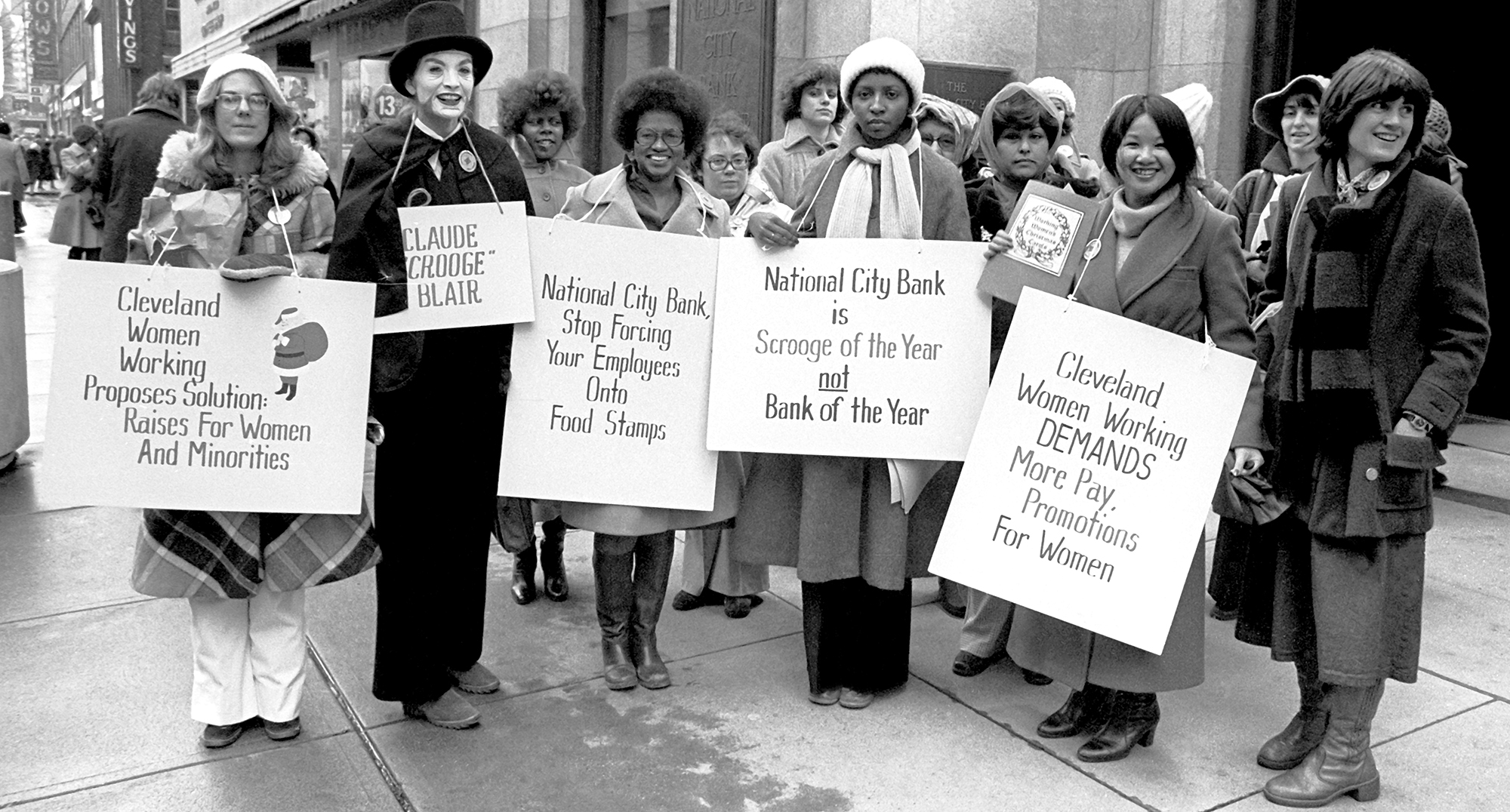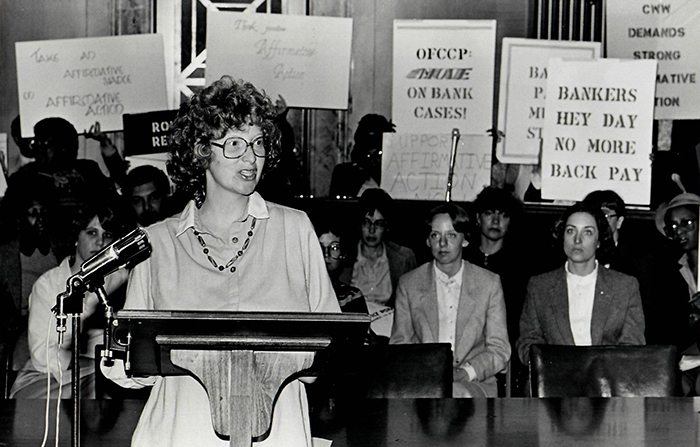
Beginning in the 1970s, 9to5 worked to improve conditions for women in industries including banking, publishing, insurance, and law. (Photography by Steve Cagan)
Before the movie and the song, Ellen Cassedy’s (EX’72) organization 9to5 revolutionized the working lives of American women.
Ellen Cassedy, EX’72, received a horrifying introduction to the working conditions women faced in the early 1970s. There were few professional options for women when she graduated from the University of California, Berkeley. Her best friend, Karen Nussbaum, EX’72, was a clerk-typist at Harvard University, and Cassedy found a job in the same department. While she was there, a professor hired her to transcribe handwritten notes at his home. Those notes turned out to be detailed accounts of his sexual experiences.
“When I sat down at the typewriter, he took off his shirt and stood before me bare chested, waiting for ... what?” Cassedy writes in Working 9 to 5: A Women’s Movement, a Labor Union, and the Iconic Movie (Chicago Review Press, 2022). “I knew what was going on was wrong, and scary, but I had no vocabulary for it and didn’t know what to do. Heart pounding, I started typing.”
Working 9 to 5 includes litanies of abusive behavior and other indignities women faced on the job. The book recounts the work of Cassedy and many others in the women’s labor organization 9to5 to root out such dehumanizing conduct and to end the relegation of women office workers to subservient roles without fair compensation or upward mobility. Her work would help transform American office culture—and inspire a popular song and movie—though such an impact seemed unimaginable at the beginning.
Shared enthusiasm for activism forged an instant bond between Cassedy and Nussbaum when they met in James Redfield’s (LAB’50, AB’54, PhD’61) liberal arts seminar as first-year students. At UChicago Cassedy felt forced to choose between the life of the mind and engagement with the political issues of the day. Transferring to Berkeley, she embraced women’s studies, an emerging field in which “serious scholarship and social activism came together,” she says. “I wrote my senior thesis about the Women’s Trade Union League, which I later came to think of as the grandmother of 9to5.”
The 9to5 organization began with Nussbaum’s idea to convene an informal group of 10 Boston-area women to commiserate about working conditions, harassment, low pay, and a lack of advancement opportunities. As the group grew and Cassedy tried to recruit more members in the early 1970s, some women were concerned about being labeled “feminists” or “women’s libbers,” despite general agreement with the group’s mission. Others said they disputed 9to5’s objectives altogether.
“Is it really wrong to pay women differently from men? After all, aren’t women just working for ‘pin money,’ whatever that was?” Cassedy says. “We had arguments. There was a real debate during the ’70s.”
Cassedy herself was a hesitant organizer—not for lack of conviction but because she wasn’t sure she was cut out for activist leadership. She was shy and anxious about the outreach required. For phone calls, she scripted everything down to a reminder to leave “space for the other person to say hello” after her own greeting.
At Nussbaum’s urging, in 1973 Cassedy completed a six-week course for women organizers at the new Midwest Academy in Chicago, a training center for progressive political organizers founded by Heather Booth, AB’67, AM’70. The experience offered a framework for 9to5 to pursue change.

Within a year, the organization would hold a public hearing in Boston to unveil its Bill of Rights for Women Office Workers. More than 300 women filled the hall, government agencies sent representatives, and the Massachusetts legislature issued a commendation for the organization’s efforts. Though the event generated news coverage and promises from elected officials, the proposed rights still faced powerful opposition. But 9to5 was growing into a worthy counterweight.
Lawsuits generated millions in back pay and raises for women office workers. A 9to5 report on the Boston publishing industry prompted the Massachusetts attorney general to file discrimination charges against three companies. And lobbying convinced the state insurance commissioner to issue employment regulations. The standards reflected many of the tenets in 9to5’s bill of rights: “Unisex job application forms, written job descriptions, job posting, posted pay scales guaranteeing equal pay for men and women in the same job, no more dead-end jobs, new bridge jobs to create career ladders, and equal benefit plans for men and women.”
Through the 1970s, 9to5 attracted thousands of members and added two dozen national chapters. For National Secretaries Day, 9to5 chapters around the country held “Petty Office Procedures” contests that exposed demeaning tasks women were expected to do for their bosses. Entries included cleaning dentures, vacuuming nail clippings, sewing ripped pants (while still being worn), and cupping hands for a boss to use as an ashtray. The organization made a spectacle of executives who “won” the competitions, nudging office culture toward more professionalism, one public embarrassment at a time. “It became unacceptable to, for example, require your secretary to snip your nose hairs,” Cassedy says.
Her wry humor echoes the tone of 9 to 5, the chart-topping song and movie. The second-highest grossing film of 1980 after the Star Wars sequel The Empire Strikes Back—“another epic battle between good and evil,” Cassedy writes—9 to 5’s popularity generated support for the organization, which soon became a nationwide union.
Cassedy left a thriving organization in 1985. She became an author and translator, wrote a column about work for the Philadelphia Daily News, and was a speechwriter in the Clinton administration—in which Nussbaum also served, as director of the Department of Labor’s women’s bureau.
Together they helped expand professional opportunities for women and improve their working conditions. As the book notes, a persistent gender wage gap, insufficient representation of women of color in the workplace, and the #MeToo movement’s revelations of sexual abuse and harassment illustrate the challenges faced by heirs to the 9to5 legacy. The successes of that earlier era still resonate—the documentary 9to5: The Story of a Movement premiered on public television in 2021.
Cassedy likewise draws inspiration from today’s activists. The 2017 Women’s March stirred memories of the collective spirit she felt as a young woman, compelling her to write Working 9 to 5 to chronicle a previous generation’s enduring achievements and lingering frustrations. Although incomplete, their work made an indelible difference.
“We won raises, rights, and respect for millions of women,” Cassedy writes. “The offices of America have not been the same since.”
What a way to make a living.
